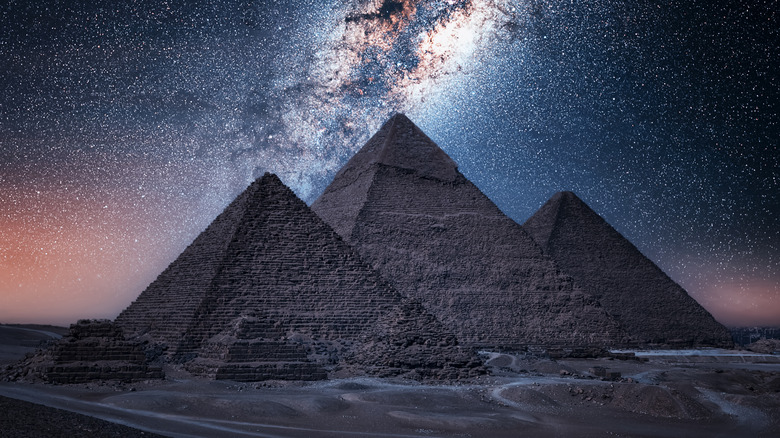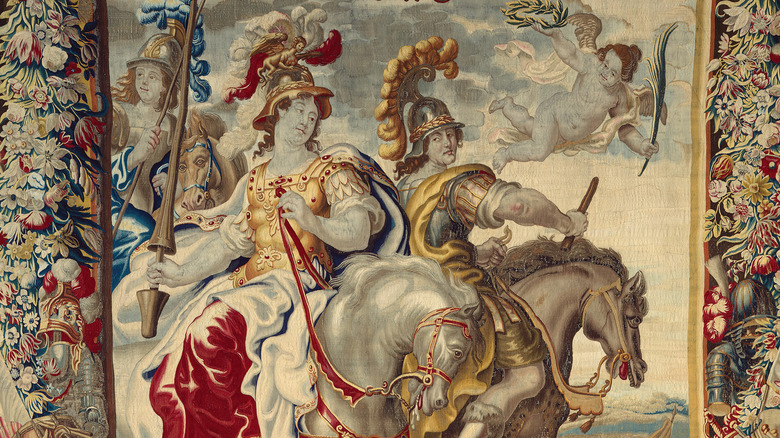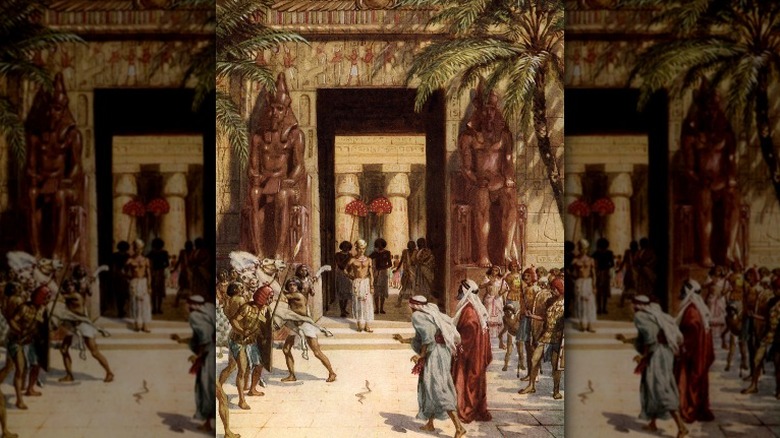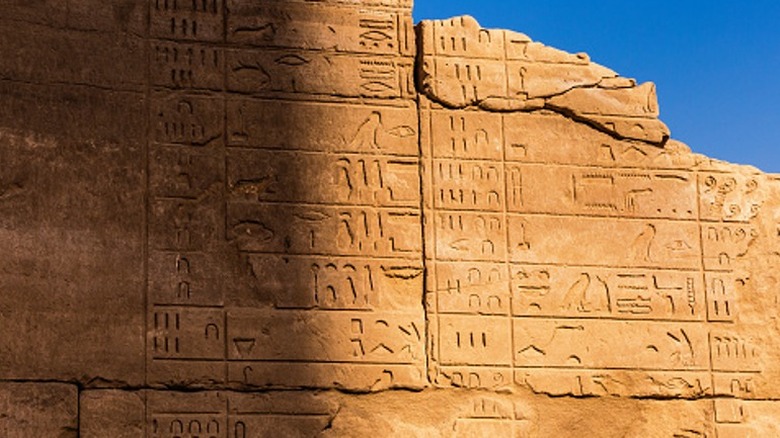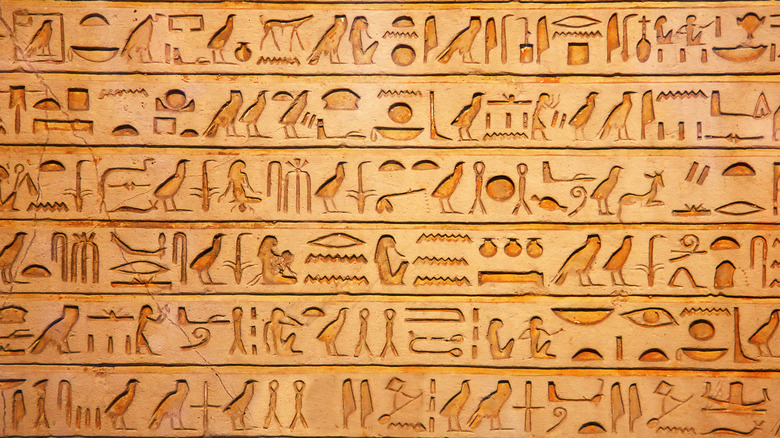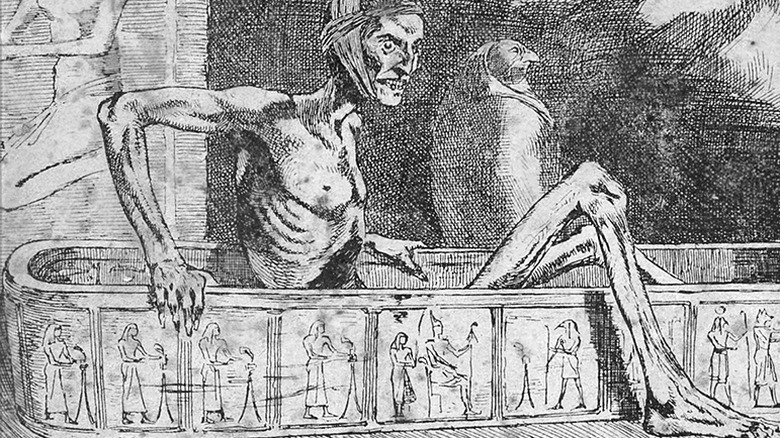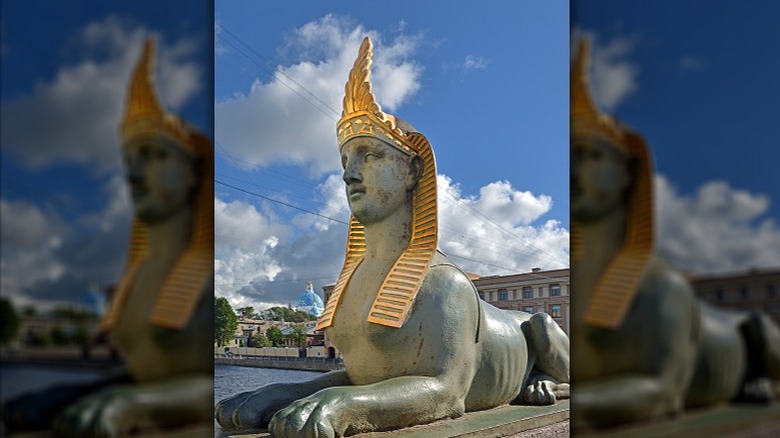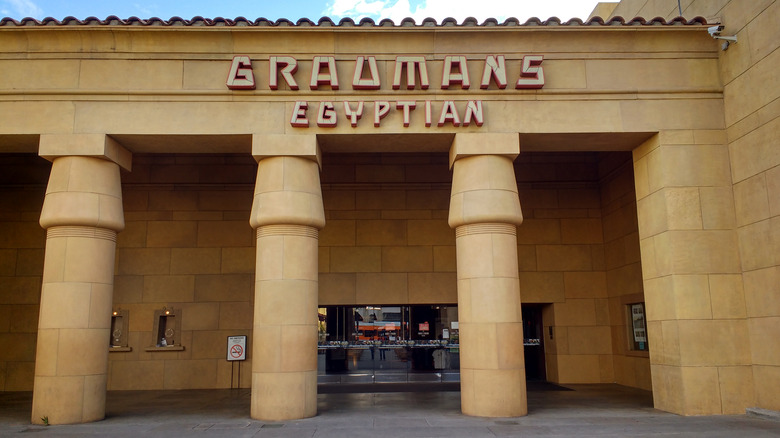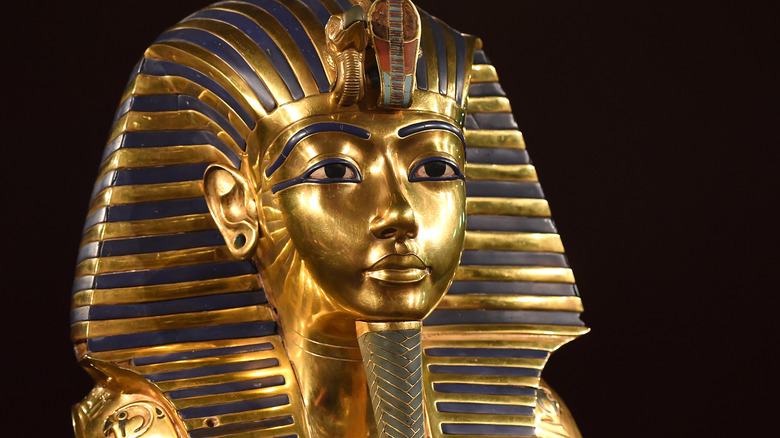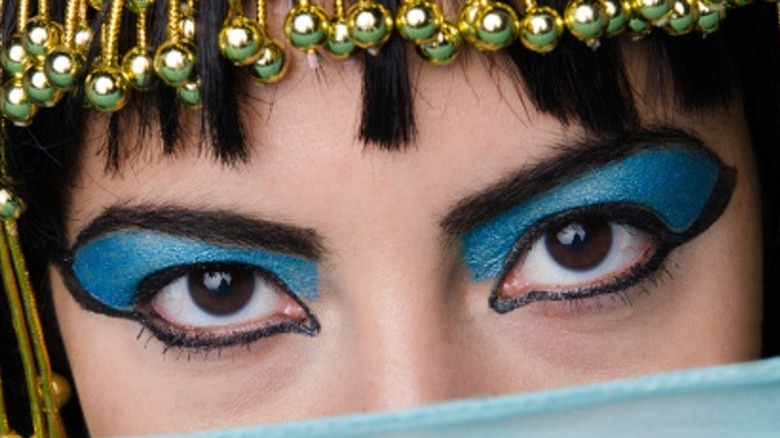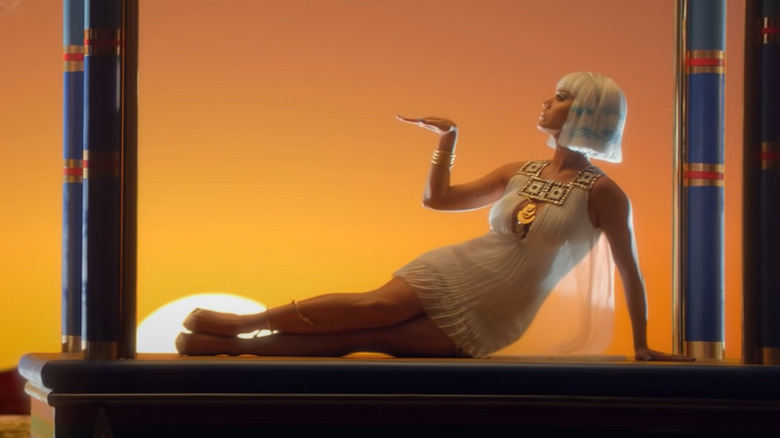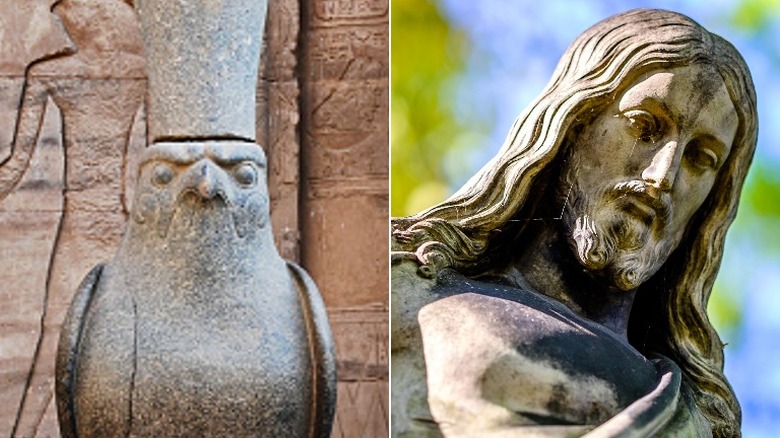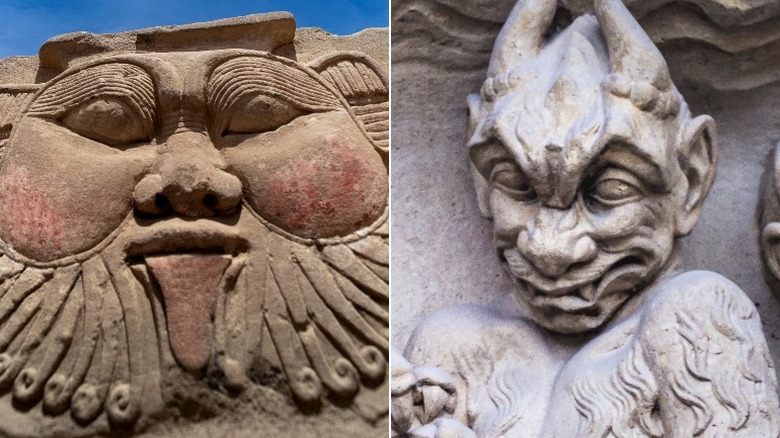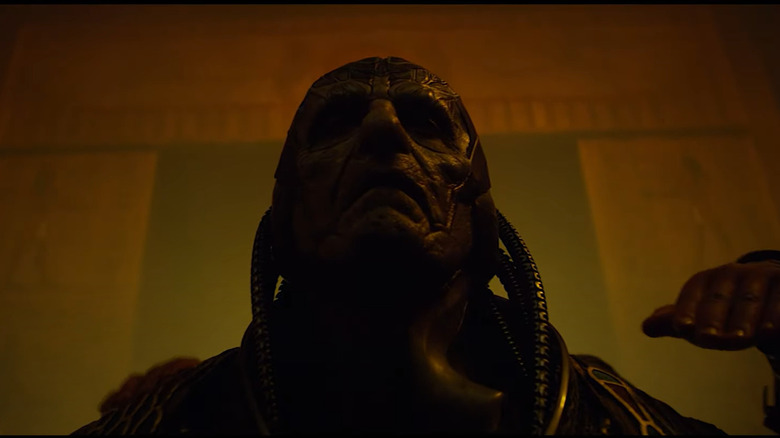How Ancient Egypt And Egyptian Mythology Influenced The Western World
Take a look at the headlines generated by Netflix's docudrama "Queen Cleopatra," or the contentious preproduction of Gal Gadot's film about the Egyptian queen, and you can see two things: history being brought into modern-day cultural debates, and a lingering fascination with Egypt. The iconography associated with Egypt — pyramids, sphinxes, nemes, tombs, and mummies — appears in everything from prestige docudramas to children's cartoons, and Egyptian exhibits remain popular, if sometimes controversial, at museums around the world. But the influence runs deeper than that. Egypt's impact upon Western civilization is so significant that there have been museum exhibits about its influence and relationship to the West, as was the case at the Yale Peabody Museum of Natural History between 2013 and 2014 (via Yale News).
Many of Egypt's contributions to Western civilization are indirect, passing through its influence on Greek and Roman culture and religious texts. Others are self-evident. But they appear across art, literature, architecture, and spirituality, sometimes in surprising ways. Here are some of the more notable examples of ancient Egypt and Egyptian mythology's ongoing influence on Western culture.
Egyptian culture entered the West through Greece
It's common to hear Egyptian, Greek, and Roman civilizations all referred to as ancient, but that can suggest that they were contemporaries. In fact, Egypt was perhaps thousands of years old by the time Greece and Rome had risen. Artists, sculptors, soldiers, sailors, and rulers looked to it as a great and mysterious kingdom, one they took as even older than it really was, and cultural exchange between the two civilizations went on for 2,000 years before Caesar and Cleopatra's romance. According to The Washington Post, the Minoans traded in goods, the Mycenaeans fought for Egypt against incursions from Libya, and the Greeks took lessons from the Egyptians in sculpture and writing. Herodotus even suspected that the Greek religion was originally Egyptian.
For centuries, Egypt was the senior partner in this relationship, the towering example of civilization. Many of our words for aspects of Egyptian civilization, like the pyramids, stem from Greek descriptions. But by 332 B.C. it was a Greek dynasty that ruled the elder kingdom. Alexander the Great, after conquering Egypt, left his general Ptolemy behind to rule, and the dynasty Ptolemy founded controlled Egypt until the death of Cleopatra. By then, Rome was ascendant, and between its own interactions with Egypt and the influence it absorbed from Greek culture, Rome fell into a mania for Egyptian culture in its imperial era. Even if Egypt itself was reduced to a vassal state, its objects, animals, and gods found eager audiences.
The Bible influenced Egypt's relationship with the West
One of Egypt's greatest purported marks on the Western world probably never happened, at least not the way it's traditionally presented. Historians disagree about the historicity of the Book of Exodus. Some maintain that there is enough evidence to suggest a seed of truth somewhere in history, with Egypt influencing the kingdoms of Judah and Israel; others maintain that there is no reason to assume any factual basis. Either way, it's widely agreed that a mass exodus of Semitic slaves out of Egypt after a series of plagues did not happen in the way described in the Bible. And yet the Biblical image of Egypt as the land of slaveholders from whom Israel escaped has had a pervasive impact on Christendom and on the broader concept of the West.
Examples survive of medieval depictions of the Exodus story, albeit with a very European look to Egypt. The word "pharaoh" became associated with despotism. And the biblical account of Egypt and Israel resonated deeply with those Europeans who left for the New World. Early colonists compared the kingdoms of Europe with Egypt, and their journey across the Atlantic to the parting of the Red Sea. Benjamin Franklin, Thomas Jefferson, and John Adams' initial suggestion for a national seal for the United States was a depiction of pharaoh's pursuit of his former slaves. And Black Americans held in bondage looked to Exodus as a source of comfort and promise (per the Society of Biblical Literature).
The Egyptians helped create the modern calendar
Certain aspects of modern life are so ingrained into our daily routines that it's easy to take them for granted, and never consider that someone would have invented or developed them. Take our timekeeping systems, for example: Marking the days by increments of 24 hours, and the years by 365 days, is so ingrained in humanity the world over that it often goes unquestioned. But it's far from the only calendar system developed throughout history, and it was by no means universal in the ancient world. Possibly the first to utilize what we could recognize as a modern calendar were the ancient Egyptians.
According to ThoughtCo, three calendars were developed in ancient Egypt over the centuries. For religious purposes, there was a 12-month lunar calendar set by the disappearance of the old crescent that occasionally needed an extra month slotted in. But for civil society and administrative work, there was another calendar, one with 12 months of 30 days and an additional five days tacked on at the end for a 365-day year, measured by the rising of the star Sirius. (The Egyptians called it "Serpet.") The third system was used to reconcile the other two.
The Egyptian civil calendar has been roughly dated back to 2900 B.C., and was reformed after the end of the Ptolemaic dynasty to include leap years to better conform to the solar cycle. Similarly aged was Egypt's dividing of days into 24-hour increments, measured by shadows and adjusted based on seasonal sunlight.
Did the alphabet come from Egypt?
The writing system most associated with ancient Egypt is their hieroglyphics, pictorial representations of people, things, objects, sounds, and concepts. But hieroglyphic writing was of limited use even at the height of Egyptian civilization, because of how hard it was to produce. Greek visitors noted that many Egyptians used two other scripts written on papyrus instead; hieroglyphics were reserved for inscriptions on stone. It's long been thought that these systems had a direct influence on the earliest known alphabet, one that perhaps runs even deeper than is sometimes supposed.
The most commonly recognized ancestor of our modern alphabet is a script developed by Semitic groups living in lands within or near Egyptian control, dated somewhere between 1900 and 1700 B.C. Per Shippensburg University, the popular theory goes that scribes saw the writing systems used by the Egyptians and developed their own, which was exported to other Semitic peoples in Canaan and later to the Greeks, who developed it further into something closer to our contemporary letters.
Israeli Egyptologist Orly Goldwasser has argued for another theory. Per USA Today, her analysis of the earliest examples of this early alphabet led her to believe that it wasn't scholars studying Egyptian writing systems, but illiterate laborers who wanted to emulate carven records of gods and men, who invented proto-letters. The idea has picked up some limited academic support, but the earlier theory is still largely preferred.
Egypt was a popular subject in Western literature
Greek visitors to ancient Egypt read, admired, and translated the local literature, and it seems likely the two cultures influenced each others' stories. Such immediate connection with Egyptian culture wasn't possible for much of the Western world after A.D. 641, when Egypt fell under Islamic control. But fascination with the ancient empire remained, and depictions of Egypt in European histories and literature became increasingly influenced by Roman interpretations of Egyptian culture.
The collision of Rome and Egypt was a popular subject of Elizabethan literature and theater, notably through William Shakespeare's "Antony and Cleopatra." Though portraying a period in time when Rome was subjugating Egypt, "Antony and Cleopatra" portrays the Egyptians as winning what we might call today a culture war, supplanting Roman fashions, customs, and decadence with their own as Cleopatra seduces successive Roman leaders.
The theme of Egyptian culture triumphing over its rulers or successor states reemerged during the Victorian era, expressed through examples of what's been called imperial gothic literature. Against the background of Britain's seizing control of Egypt and the Suez Canal (per the University of Warwick), books like Guy Boothby's "Pharos the Egyptian" and Bram Stoker's "The Jewel of Seven Stars" depicted the clash of ancient magic and religion with the industrialized might of the British Empire, the latter not always faring well. Such encounters across time were also used for humor; Edgar Allan Poe spoofed the Egyptian subgenre with his short story "Some Words with a Mummy."
Egyptomania
The term "Egyptomania" has retroactively been applied to boom periods for Western civilization's fascination with ancient Egypt, from Rome's embrace of its aesthetics after the conquest of 31 B.C. to Renaissance scholars' interest in Greek interpretations of Egyptian culture. It's more specifically applied to the period immediately following Napoleon's Egyptian campaign at the end of the 18th century. The scholars and scientists who accompanied Napoleon had a chance to directly study the remnants of the ancient civilization, something that had long been difficult due to Islamic control of the country.
With primary sources now available, and with Jean-François Champollion's deciphering of hieroglyphics through the Rosetta Stone in 1822, knowledge and interest in ancient Egypt exploded in Europe. Writers and historians poured over unlocked records, artists and craftsmen incorporated the aesthetics of Egypt into their work, and an obelisk was erected in Paris. Egyptomania was perhaps strongest in Victorian Britain, which both romanticized Egypt as a glowing example of past empires and a cautionary tale for their own future. According to The Collector, 19th century Britons embraced Egyptian influence in everything from a prominent display in Prince Albert's Great Exhibition of the Works of All Nations to the pharaoh-headed buttons on men's coats.
The Egyptian Revival and modern architecture
Ask someone to picture ancient Egyptian architecture, and they're likely to think of the pyramids of Giza or the sphynx. But as a 3,000-year civilization, Egypt saw a diverse range of building styles, leaving later, Western architects plenty to choose from when emulating their designs. The 19th century saw waves of revival design, contemporary applications of the aesthetics and principles of more ancient styles to building and decoration. The Egyptian Revival, kicked off in part by the Napoleonic campaign of 1798 (per The Metropolitan Museum of Art), lasted over a century and gave designers and consumers a taste of the exotic through varying interpretations of Egyptian motifs.
The obelisk of Paris and the design of the Washington Monument were two early examples of Egyptian Revival designs applied to public works. From monuments and private buildings, the revival trickled down to furniture, textiles, and eating utensils. With the discovery of King Tutankhamun's tomb in 1922, the movement gained a second wind, and Egyptian motifs became a key component of art deco. Overtly Egyptian designs became particularly popular for movie theaters in America after the tomb made headlines.
Inspiration from ancient Egypt can still be found in modern architecture. The glass pyramid of the Louvre has welcomed visitors since 1989, and within Egypt itself, old and new styles have been melded by contemporary designers.
King Tut's tomb launched a cinematic subgenre
There is no reason to believe in a curse on King Tutankhamun's tomb, or any other pharaoh's except for a few early grave walls in Giza and Saqqara. The myth has been traced to Victorian stage shows built around mummies, picking up traction in the press after Tutankhamun's tomb was uncovered in 1922. Very few people involved in excavating the site suffered untimely deaths, but the handful who did, including archeologist Howard Carter, always inspired headlines warning of the curse of the pharaohs against anyone who desecrated their resting places. The same claims also inspired a cinematic subgenre.
Egyptian mythological themes and mummies already had a strong presence in gothic literature by 1932, the year Universal Studios released "The Mummy." According to the documentary "Mummy Dearest" (via YouTube), the film began as an adaptation of the real-life story of Cagliostro, until screenwriter John L. Balderston, who had covered the opening of Tutankhamun's tomb as a journalist, brought in his working knowledge of Egyptian history and the made-up mythology of ancient curses. "The Mummy" brought a romantic element to Universal's growing catalog of horror films, and was one of Boris Karloff's most famous roles after Frankenstein's monster.
The success of "The Mummy" inspired several sequels by Universal, met with gradually deteriorating reception. But mummy movies took on a new life with other studiosin later decades, and writer-director Stephen Sommers brought the subgenre back in a big way with 1999's "The Mummy."
Egyptian practices still influence modern makeup
In ancient Egypt, makeup was practical as well as aesthetic. Dark color painted around the eyes helped protect against the desert sun, and makeup preparation using animal-themed tools was believed to transfer some essential power of the animal to the wearer. According to CNN, the makeup regimen common among the elite of Egypt's Middle Kingdom period was as elaborate as anything seen today, and similar care was taken in making up the dead. Mummies have been found buried with their makeup, along with combs and scents.
The particular makeup look most associated with ancient Egypt derives more from the elaborate and idealized death masks of mummies than from real life. But that look has exerted a strong influence over modern makeup trends, particularly through romantic depictions of Cleopatra and Nefertiti. Cosmetic tie-ins were a major component of marketing for the 1963 film "Cleopatra," and Rihanna adopted a Nefertiti-inspired look for a photoshoot in 2017. Some authentic Egyptian makeup practices have even made a comeback in recent years; a mixture of sugar and honey developed in ancient Egypt has been embraced as an alternative to hot wax.
Egypt has a presence in pop music
With ancient Egypt inspiring art, novels, architecture, and film, it should be no surprise to find references to it in popular music. Egypt's treatment in pop hasn't often been terribly serious. The Bangles evoked it in a lighthearted manner with "Walk Like an Egyptian" in 1986, and the decade before, Steve Martin spoofed a touring exhibit of the relics of Tutankhamun with the novelty song "King Tut."
The latter song made headlines decades after its release when students at Reeds College protested being shown the "Saturday Night Live" sketch made out of the tune in 2017. According to The Atlantic, members of the Reedies Against Racism (RAR) student group complained about the required Humanities 110 course that showed the sketch, finding "King Tut" inexcusably racist and inappropriate to show in the classroom. It was part of a larger critique of the course, one that began losing student support due to RAR's tactics against fellow classmates and faculty.
A slightly deeper approach was taken by Katy Perry in incorporating Egyptian themes into the music video for her song "Dark Horse." Since the song features rapper Juicy J, who hails from Memphis, Tennessee, Perry proposed shooting in Memphis, Egypt (per Time). The concept faced some complaints of cultural appropriation, but Egyptologists asked about the video found it fairly accurate, including the use of Greek costume to reflect Cleopatra's descent from Ptolemy.
The Horus myth and criticism of Christianity
Among certain circles of atheists and critics of religion, a theory holds that nearly every element of Jesus' story was appropriated from the Egyptian gods Osiris, Isis, and Horus. Osiris was lord of earth and paradise, betrayed and mummified by his jealous brother Set. His wife, Isis, accomplishes his resurrection, and in so doing gives birth to their son Horus. The revived Osiris becomes lord of the dead and the guarantor of rebirth, while Horus ruled Egypt. Both were also meant to be aspects of the sun god, Ra.
On the surface, similarities to the story of Jesus appear slight; there are divine father-and-son figures that are separate and one, and there's the promise of a resurrection of some kind, but there are many more differences. But certain interpretations of the Horus myth, relying on translations by Gerald Massey (per Catholic Answers), posit that Christ was an invented figure created from the Horus myth. The film "Religulous," heavily critical of Christianity, described Horus as born of a virgin, having 12 disciples, and being crucified and resurrected.
Against these claims, Christian scholars and historians have noted the poor reputation Massey's translations have with Egyptologists. It's from Massey that "Religulous" got the idea of 12 disciples, an idea not found anywhere else. Horus's birth was miraculous but not virginal, and evidence for "crucifixion" is limited to carvings of Horus with his arms outspread.
Egyptian gods provided the face of the devil
Some gods of Egyptian mythology and religion were fully endorsed by the government; others went without official sanction, but could still be widely popular. Such was the case for the god Bes, connected to alcohol, sex, music, and an all-around good time. His image was thought to offer protection, not unlike medieval gargoyles, and his squat, leering portrait is found on a large number of Egyptian relics.
Egyptian art is thought to have influenced Western religious art from an early age. If claims that Jesus is derived from Horus are poorly supported, claims that early Christian depictions of Jesus and Mary together drew on pictures of Horus and Isis may be more credible. In a similar fashion, according to the BBC, some historians think that Bes may have shaped images of the Christian devil. Bes was sometimes pictured with snakes, and serpents gradually became part of Satan's iconography. Bes amulets were often blue, as were representations of the devil in certain medieval paintings. And Bes' broad, grinning face was echoed in early Western Satans.
Such similarities are fairly broad; the same could be said of Satan and the Greek god Pan, who was also tied to earthly pleasures. One theory holds that such gods were incorporated into Christianity, in the guise of pure evil, to let the new monotheistic religion compete with the popular pantheons of old.
Egyptian mythology and comic books
If no superhero directly derived from Egyptian mythology has gained the fame of Thor or Wonder Woman, ancient Egypt has still exercised a long influence on comic books and their spin-offs. 2022's "Black Adam" didn't enjoy the critical or financial success of rival films, but the title character is meant to be an ancient Egyptian granted power by several gods. From Shu, he gains stamina; from Amun-Ra, strength; from Menthu, courage; and so on. Hawkman and Hawkgirl were also originally conceived as Egyptians, though they have at times been retconned as denizens of the planet Thanagar. And other heroes in the DC pantheon have been reinvented as Egyptian or Arab American in recent years.
In the Marvel camp, a powerful mutant was taken as a god by the Egyptians in "X-Men: Apocalypse" (via YouTube). Khonshu, the god of the moon, ties into the backstory of Moon Knight. He's also part of the Heliopolitans, a group of immortal beings inspired by the Egyptian pantheon.
